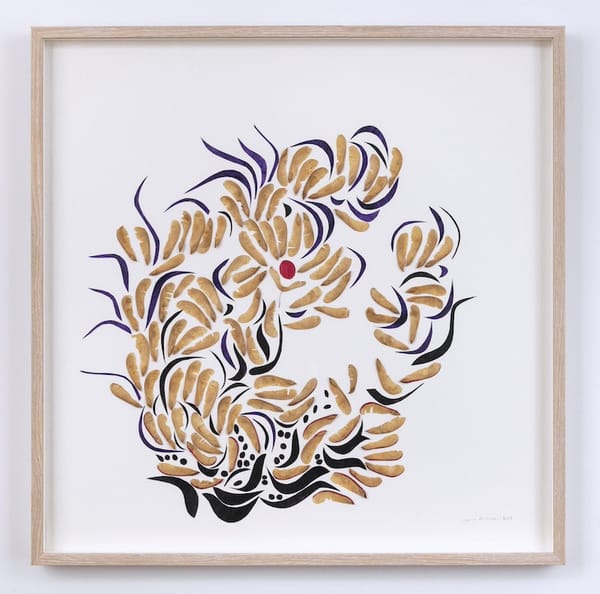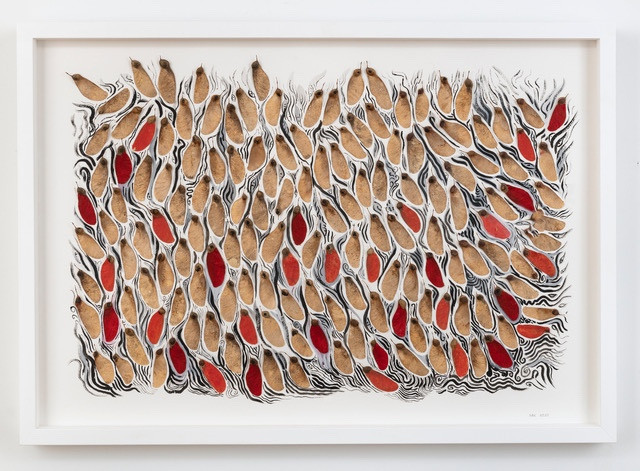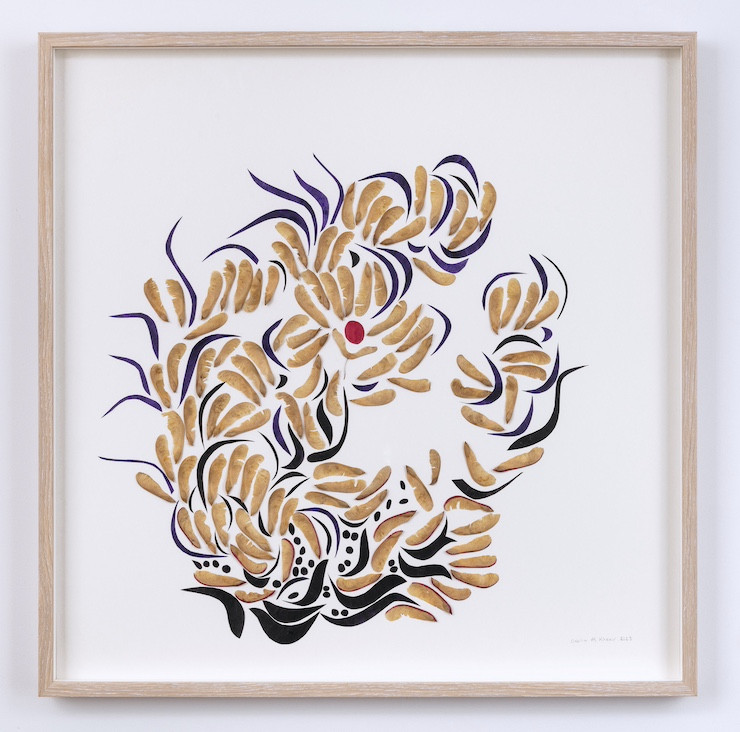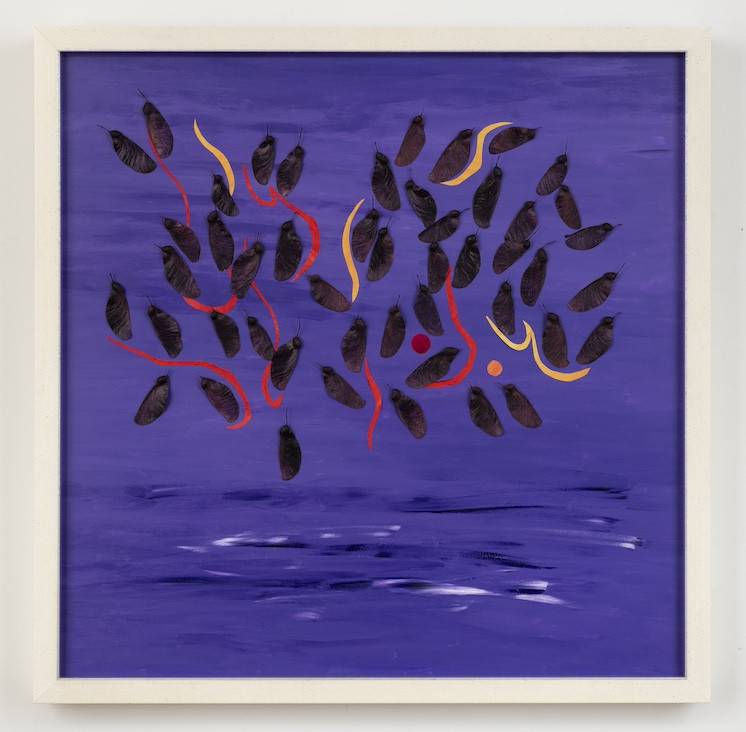Winged Helicopter Seeds Take Creative Flight In "The Samara Series"
Sabiha Al Khemir’s work with samara seeds reflects her own migratory pattern and the influences of Islamic art.

Sabiha Al Khemir’s work with samara seeds reflects her own migratory pattern and the influences of Islamic art.

"Free Spirit"

An artist, consultant, museum curator and preeminent authority on Islamic art, Tunisian-born Sabiha Al Khemir was stranded for months in Spain during the pandemic. While there, she discovered helicopter seeds —samaras — blanketing the ground. They led her on an artistic journey that has culminated in "The Samara Series," an exhibition of work using samaras, collage, and painting. The seeds she uses are those she has collected from all over the world. “This art project is the story of a special encounter of engaging with samaras,” she says. “I hope this exhibition fosters an awareness of nature and its beauty and that visitors enjoy the dance and serenity of the samaras.”
The exhibition is on view until November 12 at The Washington Art Association and Gallery in Washington Depot. Al Khemir spoke with Rural Intelligence’s Susan Yung about her work and the exhibition.
Q: How long have you been making art?
A: I started drawing extensively at the age of 14, mainly in pen and ink. It resulted in book illustrations of old Tunisian stories and Turkish poetry. That relationship with the pen and ink stayed with me — the sweep of the pen and the modulated line’s thickness and thinness. Looking at recent works (for example, "Choir"), my relationship with the stroke of the pen is still apparent —even when I’m painting, it emerges like a seed that never left my heart.
Q: With everything you do —including curating, researching, consulting, writing —how have you found time to make art?
A: Do I wish there were more than 24 hours in a day? Yes, like most of us.
When I work I tend to give wholeheartedly to it, like nothing else that matters at that moment. In a way, deadlines help structure the work — I respect my deadlines. The balance between fixed and fluid makes for an interesting dance compatible with my nature. The key to making it all happen is to stay attentive to what’s important at that moment and how I can be most productive. When I get up, I might have a plan from the day before but what helps is a tuning-in to the state of mind I’m in that day. If it is an art day, I give all to art; if it is a research or writing day, then it is that. And although the nature of work is different in each of these fields, they nourish and advance each other.
My approach has always been interdisciplinary. I didn’t set out to do all these things, but I discovered I am these different things. Sometimes, these facets have conflicting demands and I’m there to keep the peace. I also have a sense of wholeness when all these disciplines are flourishing. There’s the opening of the Samara exhibition on October 14, and I was in Paris for an exhibition of rock crystal at the Cluny Museum (National Museum of the Middle Ages) on September 25. My input for that was scholarly — writing in the catalog about Islamic rock crystal in the Middle Ages.

"Choir"
Q: In "The Samara Series," do you ever let chance play a role in creating compositions?
A: Absolutely. Most of the time, I start with a general sense of where things will go, like the direction the wind is blowing, but there isn’t a pre-determined place to end up. I am often surprised by how the artwork turns out. Looking at the pieces in this exhibition, even when they seem planned the reality is they were shaped by what I would call a spontaneous order. The work with the seeds has an organic aspect to it. Even when I do interpretations of the same work, no two pieces are the same. I feel constrained if I have to copy myself. Often I begin by arranging the seeds according to an initial idea, but then when I finalize a work I make adjustments.
For example: in "Explorers" where the samaras dance on the page — each seeks its own purpose but engages with the seed next to it. There’s a play of the seeds on paper and I’m following them. It is a kind of expressive contemplation. In "Flying Fish" I was surprised by the surge of color while engaging with the seeds. It was not planned, it was a euphoric burst.
Q: How many species of samaras have you worked with?
A: The first samaras I collected from our garden in Spain came from a Tipu tree; I made a work called "Origin." I worked with samaras from a Japanese maple tree in Tacoma, Washington, and from maple trees from Connecticut and Maine. I have also worked with samaras from Ukraine, Latvia, and Lithuania. Samaras come from field maple, sugar maple, ash, Norway maple, sycamore, elm… I’ve worked with about a dozen types.
Q: Do you ever work with the kinetic potential of samaras, or is your art primarily 2D?
A: Interesting question! I haven’t made 3D mobile work with samaras. On canvas I’ve been creating moments to contemplate a sense of movement, like in "Free Spirit." The dynamic involves combining nature and play. Nature and paint. Collage. Bringing fragments together. Telling stories to explore an emotional space. And the format might move to 3D and motion. I wouldn’t rule out kinetic work. I welcome changes of style and approach.
Q: Where is your home base upstate, and how did you wind up there? And do you split your time between residences?
A: Our home is in Bridgewater, Connecticut. Friends who have a home in Bridgewater inspired us. I fell in love with the woods and the trees everywhere. Nature is very beautiful in this area. The old trees are amazing, not to mention the birds! We divide our time between Connecticut and New York City. One reason we chose Bridgewater is that in a short time you are in a totally different environment, deep in the countryside. The peace and serenity is extraordinary. The intense pulse of the city gets too much at times and nature in Connecticut is a wonderful balancing act. It has played a central role in my work in the samara series.


